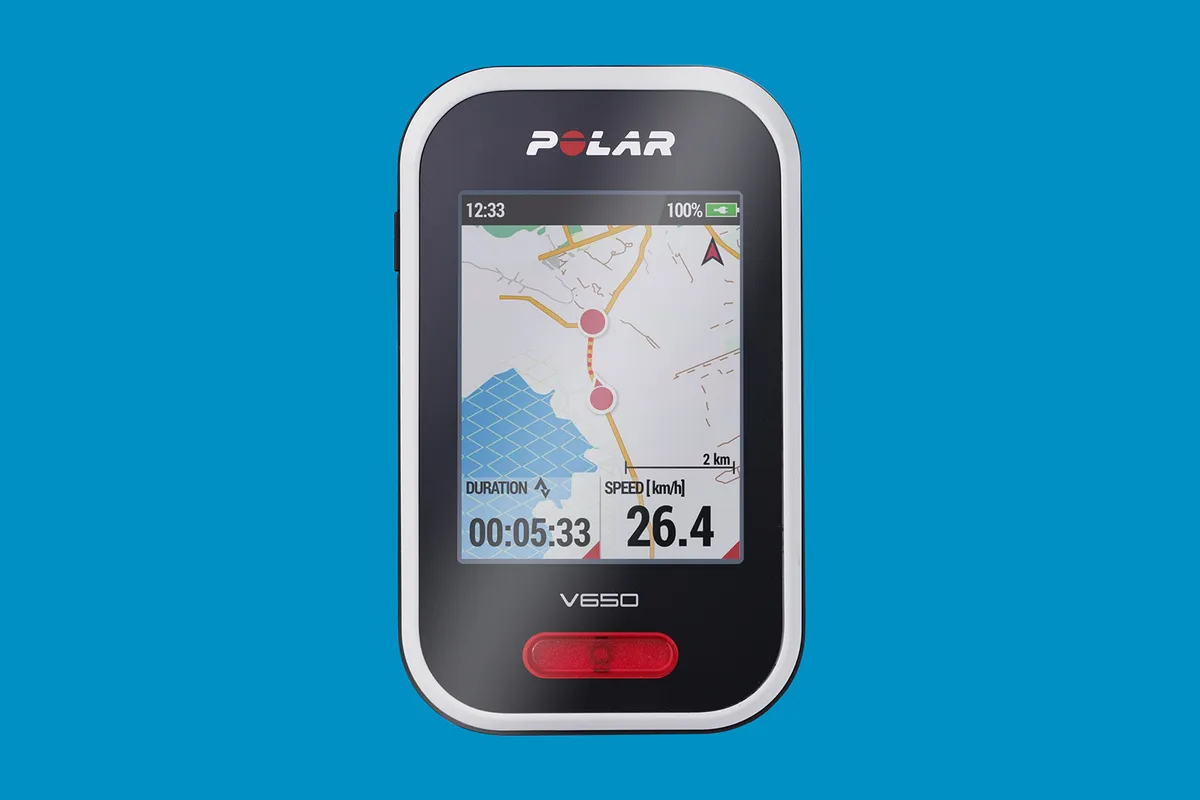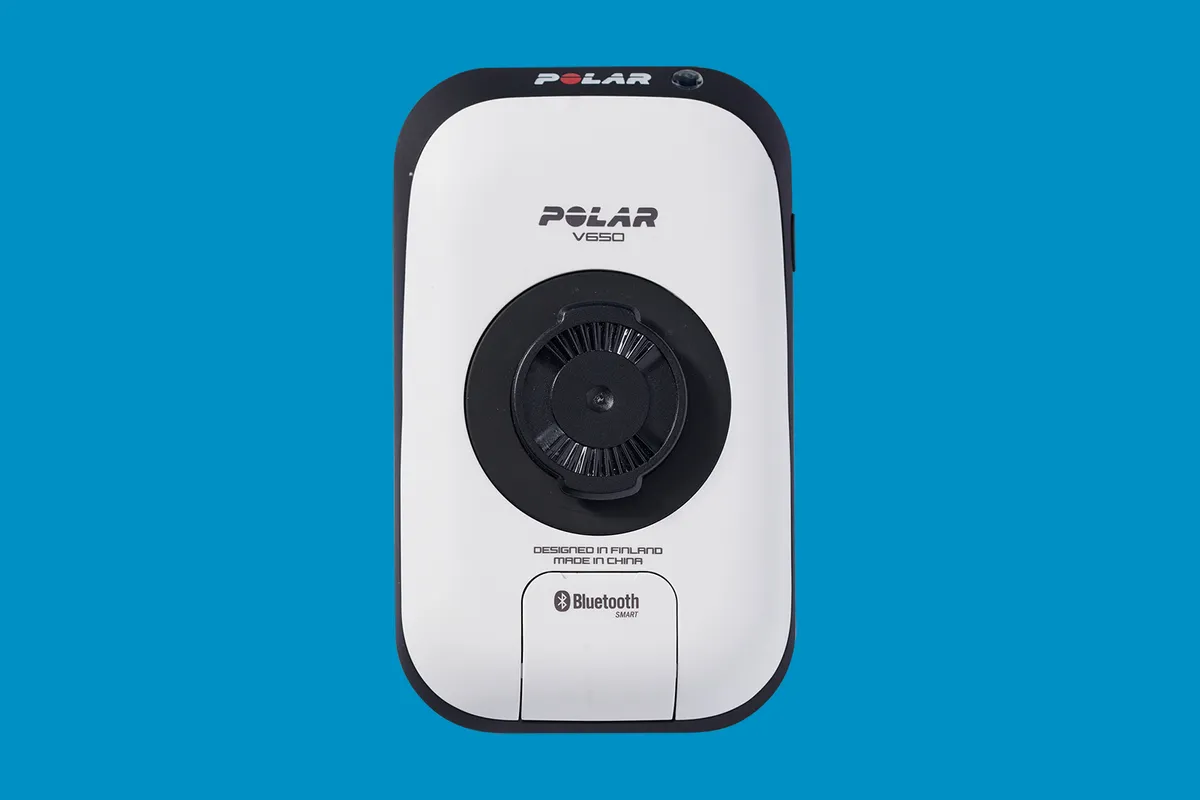Polar has a well-earned reputation for sports watches, so the idea of applying the same knowledge to a GPS unit sounds promising, especially when you factor in a colour display with touchscreen and Polar’s excellent OH1 heart rate sensor.
The unit is well designed with a robust case, although the bulky bar-mount isn’t a patch on a Garmin-style quarter-turn unit, plus there isn’t an out-front mount included.
The bulky mount doesn’t hold the big unit particularly well either, which leads to a lot of vibration over rougher road surfaces, and the chunky rubber O-rings take some stretching before they’ll properly seat in the mount, too.
Polar V650 set-up
The initial set-up is easy once you get the unit to connect – this can be a chore in itself and I tried four laptops to no avail. It finally played ball when connected to a laptop with no software beyond 2018’s macOS Mojave.
Looking through the various forums it seems as if Polar’s software clashes with certain antivirus software among others, but seeing as the V650 is dependent on connecting to your computer via USB to set up it's quite a problem.
Once you’ve established a connection and performed the initial registration, set-up is easy via a computer or phone, and the GPS signal pickup is reasonably quick – I got between 39.6 seconds and 53.7 seconds over several rides.
Where Polar really scores highly, though, is with its multitude of training options, which have great metrics such as recovery status and ride load on your body (providing you’re using power and heart rate monitor sensors).
Sensor connection is easy with a few touchscreen presses to search and connect – I had no trouble connecting with anything I threw at it, although the sensor connections are only via Bluetooth, so some older power meters and heart-rate straps using ANT+ won’t work here.
Also, if you have a sensor drop out mid-ride the V650 can’t reconnect when it’s recording. This means you have to stop, save, reconnect and start again, which was a frustration on my longer test rides.
Syncing with Strava is simple and offers full compatibility so you can transfer routes directly from Strava to the unit.
Polar V650 screen

Screen set-up is fully customisable – altering the profile between ride styles and using the customisation throughout the data fields means you can get a truly bespoke feel to what you’re seeing.
The screen itself is bright and easy to read, and the touchscreen works well enough with gloved hands, with only the occasional failure to sense touch – it’s good but not quite as good as Garmin’s.
Saying that, the screen suffers an issue that we last saw on Garmin’s last-gen Edge 1000 where rain activated the screen. On one particularly wet test ride, I watched as the V650 went off on its own journey of discovery through menus and sub-menus without my input.
At the front of the unit is a single LED light, which can be switched on or off via the menu. As a light to see by, it's nothing of note but as an emergency option to be seen when the conditions turn it’s a welcome feature.
The mapping screen is efficient – simply download a 450×450km tile from OpenStreetMap on the Polar Flow website and upload it to the unit. You can also pinch-zoom (like you would on a phone), although this is difficult to do with gloves on.
Note, there is no turn-by-turn navigation, and a downloaded .gpx route merely shows up as a line drawn on the map. Most of the time this isn’t an issue because it’s only in more built-up urban areas that the map can get confusing, especially when there are multiple turns or junctions ahead, but when you’re riding in the great outdoors it’s fine.
Battery life is a claimed 10 hours. With a full suite of sensors connected and using it to navigate I eked out just under eight hours, which is pretty good. If you switched off the auto-backlight and a few non-essential functions, then 10 hours would be achievable.

Polar V650 overall
The V650 has a lot going for it beyond the highly competitive price but it’s not all rosy, sometimes connection to the app and desktop can be flaky because the unit is not recognised immediately.
However, the user interface is good, but the lack of proper turn-by-turn navigation is a big omission. Finally, having to stop recording to reconnect a sensor is frustrating, but not as frustrating as trying to get the V650 up and running in the first place.
How good is the Polar V650 for mountain biking?
Even on rough terrain, the Polar V650’s touchscreen is easy to use. This is helped by the straightforward user interface, which makes scrolling between displays simple and less likely to cause a crash.
The 450×450km on-device map is scrollable even without a route and the OpenStreetMap data is clear and detailed – navigating without a route is simple and pleasingly easy.
The pinch-to-zoom and scroll functions require no physical button pushes to operate, functioning like most intuitive smartphones. Meanwhile, mapping is one of the device’s standout features. However, the map can be hard to scroll and zoom while riding. There are also no turn-by-turn instructions or rerouting if you go off course, and you have to follow a breadcrumb trail along your planned route.
Finally, in very rough terrain, the weight of the device can overwhelm the bar mount's rubber O-rings, while water droplets can activate the touchscreen.
Despite the V650’s foibles, when compared to other GPS units at this price, it offers great on-trail performance and that’s mostly thanks to its mapping. If you’re on a budget I’d recommend putting up with the V650’s quirks so you can use it as a true navigation companion while also tracking your rides.
Product
| Brand | Polar |
| Price | £190.00 |
| Weight | 120g |
Features
| Strava live segments | yes |
| Features | Memory: 1,400 hours In the box: Polar OH1 optical heart rate sensor (armband), bar mount, micro USB cable |
| Dimensions | 105mm x 62mm x 16mm |
| Battery life | 10 hours (claimed) |
| Water resistance | IPX7 |
| Screen dimensions | 43mm x 58mm |
| Display resolution | 320 x 240 |
